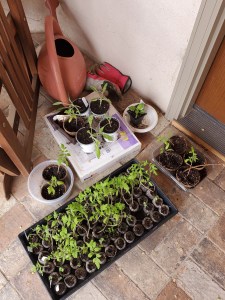May 2025 Wrap-Up
New Additions
Both April and May 2025 were full of travel and events. Books were read and some were reviewed. Plenty of hours were logged in both the garden and the quilt room. The only thing lacking was regular writing.
Two new babies were born into the family twenty days apart. One of each gender, identical in length and only an ounce apart in weight. Since the cousins live but five miles apart it will be interesting to see if they are misidentified as twins. I look forward to holding them simultaneously.
Messages to Econogal
 I try to keep up and acknowledge the emails that come into the blog. Unfortunately, the majority want me to let them publish what they write thereby skipping the cost of a website. Others want me to write on their topic of choice. The vast majority are literary agents doing the job of promoting a client’s book.
I try to keep up and acknowledge the emails that come into the blog. Unfortunately, the majority want me to let them publish what they write thereby skipping the cost of a website. Others want me to write on their topic of choice. The vast majority are literary agents doing the job of promoting a client’s book.
My favorite correspondence is from writers themselves. Some write in the comments, others reference my blog on their websites and still others send private notes. This month I learned Ken Steele was recognized by the Oklahoma Department of Libraries in May 2025 with an award for The Promise of Unbroken Straw. Kudos to Ken, I am still gifting his book to various individuals in my circle. I highly recommend it.
May 2025 In the Garden
Much time is spent in the garden at this time of year. I have a row of potatoes and a row of tomatoes in the Big Garden. Green onions are interplanted with the tomatoes and basil with the potatoes. I also have a row of leafy plants. Multiple types of lettuce and broccoli are in this row with more green onions and some rather anemic artichokes.
The final row includes hot peppers, beets, carrots and peas. My early starts of peanuts did not make it. However, I threw some peanut seeds into this fourth row as well and was quite pleased to see a couple of plants pop through this week. No doubt the inch of rain accompanied by warm, seasonal temperatures helped the garden along.
May 2025 In the Library
Two books, both set in Italy were reviewed this past month. Every Time I Go on Vacation, Someone Dies is a cozy murder mystery laced with romance. One Good Thing is superb historical fiction. In addition to the two outstanding books I reviewed this month, I reread books by Janet Evanovich and Diane Mott Davidson. I love both authors. Since I love re-reading certain series, I am thinking of having some throwback reviews in the future.
Personal News
But first, I need to attend to my health. Something is not quite right with my heart. Fortunately, I have an appointment with a specialist at UC Health in Denver next week. Those of us in small rural towns scattered throughout this country travel out of town when medical issues are complex. Hopefully the diagnoses will be quick and the remedy straightforward. In the meantime, I plan to live as stress-free as possible. And I do plan to keep all of you up to date. Happy June to all.
Share this:
- Click to print (Opens in new window) Print
- Click to share on Facebook (Opens in new window) Facebook
- Click to share on LinkedIn (Opens in new window) LinkedIn
- Click to share on X (Opens in new window) X
- Click to share on Pinterest (Opens in new window) Pinterest
- Click to email a link to a friend (Opens in new window) Email






















 I use Twitter to keep abreast of news. But, I follow-up by searching for source information. Yesterday the Twitter feed piqued my interest with a trending item relating increases of liver disease in the under 34 population with The Great Recession. Naturally, I am interested whenever I see society impacted by economic events. Also, I look for the reverse; societal events which impact economics. The interchange is often life changing.
I use Twitter to keep abreast of news. But, I follow-up by searching for source information. Yesterday the Twitter feed piqued my interest with a trending item relating increases of liver disease in the under 34 population with The Great Recession. Naturally, I am interested whenever I see society impacted by economic events. Also, I look for the reverse; societal events which impact economics. The interchange is often life changing.